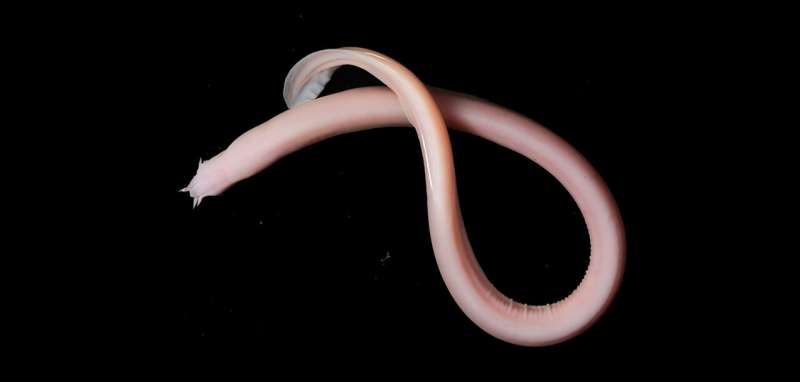A recently discovered species: The Galapagos Ghost Hagfish (Myxine phantasma). Credit: Tim Winegard
Researchers find large hagfishes grow extremely large cells in order to produce stronger threads that are used in their defensive slime, reports a new study from the Chapman University at Orange, California.
Animal cells generally don't change with body size (with very few exceptions). For example, the size of liver cells is not much different between a mouse and an elephant. Previous studies in mammals showed that brain cells and fat cells could significantly change with body size, mainly because they serve long-term functions and are allowed to grow without undergoing cell division.
"Our work showed the largest known scaling exponent in animal cells," said Dr. Yu Zeng, a research associate at the Schmid College for Science and Technology at Chapman University and the first author of the study, which was published in Current Biology. "We analyzed the size of hagfish gland thread cells—which make silk-like threads that reinforce hagfish slime—and found that they increase with body size. This means, on the evolution tree of hagfishes, the large species all make large thread cells, despite the fact that they are distantly related."
When attacked by predators, these eel-like, deep-seal animals eject mucus and threads—which quickly form a slime that can clog the predator's mouth and gills. The threads form a network within the slime and impart strength to it. Scientists are eager to learn more about hagfish slime in order to understand how super biomaterials evolved in nature and use that knowledge to inspire engineering.
In this work, the researchers sampled 19 species of hagfishes, large and small, and many were museum specimens. They developed a workflow to measure the size and shape of many thread cells from microscopic images and combined the dataset with an evolutionary tree. Two undergraduate researchers, Skylar Petrichko and Kristen Nieders, both coauthors of the paper, were involved in the morphology data collection. In the end, the researchers obtained measurements from 11,700+ cells from 87 hagfishes that were 10—80 cm long.
Compared to other cells in vertebrates, the thread cells are extremely large. The largest ones are about 250 micrometers long, which is even bigger than abdomen fat cells in elephants. Not only are hagfish thread cells larger than most cells, but their size is also highly dependent on the body size of the hagfish. The thread cells show a scaling factor (the exponent in power-law scaling with body size) of 0.55, which is much larger than the highest known cell scaling exponent found in vertebrates (exponent of 0.18 for mammalian brain cells).
The researchers wanted to find outlearn why the thread cells grow so large and hypothesized that it has to do with selective pressures on the mechanical performance of the threads they produce. They developed models to estimate the length of threads based on their diameter and the cell volume and found the threads become thicker and longer in larger cells. "The largest hagfishes, about 120 centimeters long, can make threads 4 micrometers thick and about 20 centimeters long," said Yu. This finding suggests that larger hagfishes likely interact with larger predators and therefore need to defend against more powerful attacks.
"There are several ways in which larger threads may be useful for larger hagfishes" said Dr. Douglas Fudge, the principal investigator and senior author of the paper. "Thicker threads can withstand more force before they break and make the slime stronger and better able to remain on the gills of a large and powerful fish predator. Longer threads have a similar benefit in that they can span across larger distances between the gill arches of large predators."
"Very little is known about hagfish behavioral ecology, especially how it changes with body size. Our study suggests that body size-dependent interactions with predators have driven profound changes in the defensive slime of hagfishes and these changes can be seen at the cellular and sub-cellular level," said Yu.
The researchers are currently studying the intricate development of the thread within gland thread cells. "We hope to find out how each thread is packed into a complex structure within a tiny cell," said Yu.
More information: Yu Zeng et al, Evolution of a remarkable intracellular polymer and extreme cell allometry in hagfishes, Current Biology (2021). DOI: 10.1016/j.cub.2021.08.066
Journal information: Current Biology
Provided by Chapman University
























